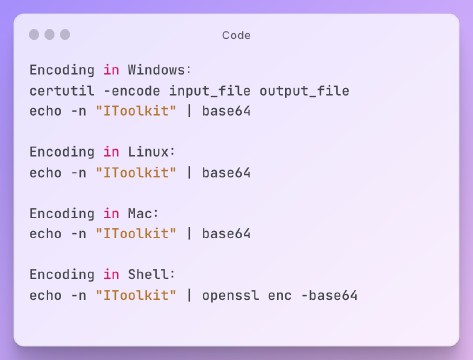Excerpt§
In this blog post, we will delve into the reasons why encrypted data is always Base64 encoded. We will explore the purpose and advantages of Base64 encoding for encrypted data, as well as the relationship between encryption and Base64 encoding. Additionally, we will discuss the Base64 encoding process and security considerations. By the end of this article, you will have a better understanding of the necessity of encryption and the role of Base64 encoding in securing data communication.
Encryption is widely used today to protect sensitive information and ensure secure communication. It transforms plain, readable data into encrypted, unreadable gibberish. However, the output of encryption is binary data that contains non-printable characters. To transmit or store this encrypted data safely, it needs to be encoded into a printable format. This is where Base64 encoding comes in.
Base64 encoding converts binary data into a ASCII character format that can be processed properly. It is commonly used on encrypted data to make it compatible for transmission and storage. In this blog post, we will look at what exactly Base64 encoding is, its advantages for encrypted data, the relationship between encryption and encoding, the encoding process, and some security considerations around Base64 encoding.
What is Base64 encoding?§
Base64 is an encoding scheme that converts binary data into printable ASCII characters. It represents binary data in an ASCII string format by translating it into a radix-64 representation. Base64 encoding uses a 65-character subset of ASCII, including upper and lowercase letters, digits, and the ‘+’ and ‘/’ symbols.
The purpose of Base64 encoding is to ensure that binary data can be exchanged over media that are designed to deal with ASCII characters. It provides a way to transmit data when the channel or storage medium can only handle text. Some examples are email, JSON objects, XML documents and some file systems.
Base64 encoding converts each 3 bytes of binary data into 4 ASCII characters. It pads the end of encoded data with ‘=’ characters if required. This allows the length of encoded data to be divisible into 4-byte blocks.
Advantages of Base64 encoding for encrypted data§
There are several key benefits of using Base64 encoding on encrypted data:
Increased compatibility and portability: Base64-encoded data can be processed by any system that supports ASCII characters. This makes the encrypted data portable across different applications, protocols and networks. Binary data may cause issues in certain contexts like emails and file names.
Prevention of data corruption: Base64 encoding converts binary data into a reliable textual format. This provides protection against corruption that can occur when transmitting raw binary data. Single-bit errors can make the entire binary data unreadable.
Avoidance of special character issues: Binary data can contain special characters like newlines and null bytes which may cause issues in data transmission. Base64 encoding represents the data without any special characters.
Overall, Base64 encoding allows encrypted binary data to be moved between systems and programs that were built to transmit and process ASCII data. It makes the encrypted data compatible for a wide range of uses.
Relationship between encryption and Base64 encoding§
To understand the need for Base64 encoding, we must first look at the encryption process. Encryption algorithms accept plain text input and use a key to transform it into incomprehensible cipher text output. This encrypted output consists purely of binary data with non-printable characters.
While encryption outputs unreadable binary gibberish, most digital systems today can only transmit data that uses readable ASCII characters. Binary data could get corrupted, misinterpreted or lost in transmission over media designed for ASCII text.
Base64 encoding acts as the bridge between these two realms. It takes the encrypted binary data from encryption and converts it into ASCII text that can be safely transmitted. The Base64 output can be shared across programs and platforms, while retaining the security provided by encryption.
Base64 encoding process§
The Base64 encoding process can be broken down into the following steps:
Chunking: The binary input is broken down into chunks of 3 byte blocks.
Convert to base 10: Each 3 byte binary chunk is converted to its base 10 integer equivalent. For example, the binary
01101001010010becomes the base 10 integer4322.Map to Base64 table: The resulting base 10 integer from each 3 byte chunk is then mapped to the Base64 character set table. This table contains 65 printable ASCII characters.
Encode to ASCII: Each mapped Base64 character is appended to the output ASCII string. For example,
4322maps toNC0=.Pad with ‘=’: The encoded output is padded with ‘=’ characters to complete 4 character blocks. These ‘=’ are used simply for padding.
Here is a quick example encoding the binary data 01000010011001:
Chunked into 2 blocks of 3 bytes:
010 000 | 100 110 001Converted to base 10:
40 32Mapped to Base64 table:
SAg=Encoded into ASCII string:
SAg=
This encoding process allows any binary data to be converted into a ASCII text format. The Base64 output can then be safely stored and transmitted even through ASCII-only systems.
Below I will recommend a free online verification tool for you, let’s experience it!
Base64 encoding and security considerations§
While Base64 encoding allows encrypted data to be transported, it does not provide any encryption itself. Some common misconceptions around encoding and encryption are:
- Base64 encoding does NOT encrypt or secure data in any way. It simply changes the representation of data.
- The entire security is provided by the encryption algorithm. Base64 encoding has no impact on the strength of encryption.
- Encoded data should still be treated as sensitive as the original encrypted data. Encoding does not afford any extra protection without encryption.
Additionally, while Base64 encoding hides the exact content of encrypted data, the length of the data remains visible. Patterns in data length could still leak some information to attackers. For proper protection, encoding needs to be combined with strong encryption protocols like AES or RSA.
Conclusion§
Base64 provides an efficient and reliable mechanism to convert binary encrypted data into a portable ASCII format. This allows the secure transmission of encrypted data through systems that can only handle text. It enables wide compatibility and interoperability for encrypted data.
However, Base64 encoding itself does not provide any encryption or security. It relies fully on encryption algorithms to scramble the actual data. The encoded data remains as sensitive as the original encrypted content. For comprehensive protection of confidential data, encoding needs to be used alongside robust encryption like AES-256 or RSA.
Understanding the close relationship between encoding and encryption, and using them together properly gives you the ability to share encrypted data safely across diverse systems and applications.















